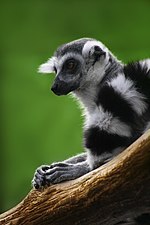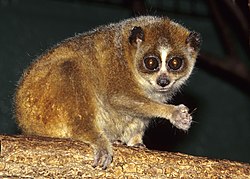Portal:Primates
The Primates Portal A primate is a member of the biological order Primates, the group that contains lemurs, the aye-aye, lorisids, galagos, tarsiers, monkeys, and apes, with the last category including great apes. With the exception of humans, who inhabit every continent on Earth, most primates live in tropical or subtropical regions of the Americas, Africa and Asia. Primates range in size from the 30-gram (1 oz) pygmy mouse lemur to the 200-kilogram (440 lb) mountain gorilla. According to fossil evidence, the primitive ancestors of primates may have existed in the late Cretaceous period around 65 mya (million years ago), and the oldest known primate is the Late Paleocene Plesiadapis, c. 55–58 mya. Molecular clock studies suggest that the primate branch may be even older, originating in the mid-Cretaceous period around 85 mya. Primates exhibit a wide range of characteristics. Some primates do not live primarily in trees, but all species possess adaptations for climbing trees. Locomotion techniques used include leaping from tree to tree, walking on two or four limbs, knuckle-walking, and swinging between branches of trees (known as brachiation). Primates are characterized by their large brains relative to other mammals. These features are most significant in monkeys and apes, and noticeably less so in lorises and lemurs. Many species are sexually dimorphic, which means males and females have different physical traits, including body mass, canine tooth size, and coloration.
Selected article
Lemurs are strepsirrhine primates, all species of which are endemic to Madagascar. They include the smallest primate in the world, Madame Berthe's mouse lemur, which weighs 30 grams (1.1 oz), and range up to the size of the indri, which can weigh as much as 9.5 kilograms (21 lb). However, recently extinct species grew much larger. As of 2008, 5 families, 15 genera, and 99 species and subspecies of lemur are formally recognized. Of the 99 species and subspecies, the International Union for Conservation of Nature (IUCN) has classified 8 as Critically Endangered, 18 as Endangered, 14 as Vulnerable, 5 as Near Threatened, 8 as Least Concern, 43 as Data Deficient, and 3 have yet to be evaluated. From 2000 through 2008, 39 new species were described and 9 other taxa resurrected.
The number of lemur species is likely to continue growing in the coming years, as field studies, cytogenetic and molecular genetic research continues. There is not complete agreement over the latest revisions to lemur taxonomy, and the debates are likely to continue. In many cases, classifications will ultimately depend upon which species concept is used. In the case of the lemurs of Madagascar, which have suffered extensively from deforestation and habitat fragmentation, nearly 25% of all species are either Endangered or Critically Endangered, most have yet to be extensively studied, and nearly all populations are in decline. For these reasons, taxonomists and conservationists favor splitting them into separate species to develop an effective strategy for the conservation of the full range of lemur diversity. Implicitly, this means that full species status will help grant genetically distinct populations added environmental protection. Selected picture The ring-tailed lemur (Lemur catta) is a large strepsirrhine primate and the most recognized lemur due to its long, black and white ringed tail. It belongs to Lemuridae, one of five lemur families, and is the only member of the Lemur genus. Like all lemurs it is endemic to the island of Madagascar. Known locally in Malagasy as maky (spelled maki in French) or hira, it inhabits gallery forests to spiny scrub in the southern regions of the island. It is omnivorous and the most terrestrial of lemurs. The animal is diurnal, being active exclusively in daylight hours. CategoriesSelected species Vulnerable (IUCN 3.1)|Vulnerable The pygmy slow loris (Nycticebus pygmaeus) is a species of slow loris found east of the Mekong River in Vietnam, Laos, eastern Cambodia, and China. It occurs in a variety of forest habitats, including tropical dry forests, semi-evergreen, and evergreen forests. The animal is nocturnal and arboreal, crawling along branches using slow movements in search of prey. It lives together in small groups usually with one or two offspring. An adult can grow to around 19 to 23 cm (7.5 to 9.1 in) long and has a very short tail. It weighs about 450 g (1.0 lb). Its diet consists of fruits, insects, small fauna, tree sap, and floral nectar. The animal has a toxic bite. The pygmy slow loris mates once every 12–18 months and has one or two offspring after an average gestation period of six months. Females reach sexual maturity by 16 months, while males reach maturity by about 18 months. The pygmy slow loris is seasonally fertile during the months of July and August. The habitat of the pygmy slow loris in Vietnam was greatly reduced due to extensive burning, clearing, and defoliating of forests during the Vietnam War. Extensive hunting for traditional medicines is currently putting severe pressure on Cambodian populations. The pygmy slow loris is seriously threatened by hunting, trade, and habitat destruction; consequently, it is listed in Appendix II of the Convention on International Trade in Endangered Species of Wild Fauna and Flora (CITES), and in 2006 the International Union for Conservation of Nature (IUCN) classified it as "Vulnerable". Did you know?
Primate lists
WikiProjectsThings to do
Associated WikimediaDiscover Wikipedia using portals |

















